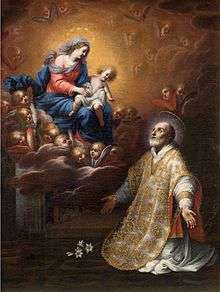Mario Balassi
_as_Saint_Vittoria_by_Mario_Balassi.jpg)
Mario Balassi (1604–1667) was an Italian painter of the Baroque period, active in Florence and Rome.

Biography
He was born in Florence in 1604, and dedicated himself from a young age to artistic education, first as an apprentice to Jacopo Ligozzi, a Veronese artist active in Florence. When the master died, he passed to the school of Matteo Rosselli, where he remained until the age of 18: and finally he became a pupil of Domenico Passignano and he accompanied him as his collaborator to Rome to work under the papacy of Pope Urban VIII[1]. But in Rome he also worked on his own behalf, performing a Touch Me Not for the church of San Caio (now destroyed) and a copy of Raphael's Transfiguration for Don Taddeo Barberini ( now found in the church of the Cappuccini): the latter was praised by Passignano and Guido Reni, who said that "Mario had not copied it, but detached it from Raphael's painting"[2].
For the non-assignment of a painting with the Crucifixion (at first committed to him and then entrusted, instead, to Sandrart) he left Piccolomini and embarked on the journey back to Italy. He stayed in Venice for some time, where he derived, according to Baldinucci, significant enrichments to his artistic personality. Returning to his homeland, he executed a significant number of altar paintings for many churches in Florence, Prato, Empoli.
In Florence, he painted a St. Francis for the Compagnia delle Stimmate. He also painted a Noli me tangere (Touch Me Not) for the convent of the Maddalena. For the church of Sant' Agostino, in Prato, he painted a picture of St. Nicholas of Tolentino, and for the Society of the Stigmata in Florence, a St. Francis.
He died in Florence on the 9th of October 1667 and was buried in Santa Maria Novella.
His art is visibly influenced by the heterogeneous pictorial education of youth, as well as by the multiple orientations of the contemporaries and the different environments in which the artist found himself. If in some works the traces of Passignano and of Ligozzi are clearly recognizable, in others they play elements extraneous to the Florentine environment, probably acquired during the Roman stay; while in some, as in the San Nicola da Tolentino of Prato, the "echoes of the Flemish-Caravaggio world" are evident. Among the stylistic components of the eclectic painter, however, is the derivation from the art of Matteo Rosselli. [1]
References
- 1 2 Chiarelli, Renzo. "Dizionario Biografico degli Italiani - Volume 5 (1963)". Treccani. Retrieved 6 March 2018.
- ↑ Baldínucci, F. (1772). Notizie de' professori del disegno... Firenze. p. 164-175.
- Ticozzi, Stefano (1830). Dizionario degli architetti, scultori, pittori, intagliatori in rame ed in pietra, coniatori di medaglie, musaicisti, niellatori, intarsiatori d’ogni etá e d’ogni nazione' (Volume 1). Gaetano Schiepatti; Digitized by Googlebooks, Jan 24, 2007. p. 98.
- Bryan, Michael (1886). Robert Edmund Graves, ed. Dictionary of Painters and Engravers, Biographical and Critical (Volume I: A-K). York St. #4, Covent Garden, London; Original from Fogg Library, Digitized May 18, 2007: George Bell and Sons. p. 70.